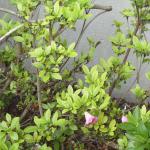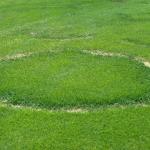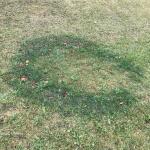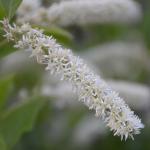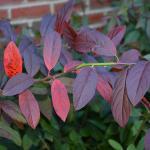A monthly e-newsletter from UMass Extension for landscapers, arborists, and other Green Industry professionals.
To read individual sections of the message, click on the section headings below to expand the content:
Hot Topics
New Fact Sheet: Why Hydrangea macrophylla Don't Flower
Customers asking why Hydrangea macrophylla don't have flowers? Check out the new UMass Extension Fact Sheet for some of the many reasons.
2018 Massachusetts Landscape and Nursery Industry Survey
What are the needs and impacts of our landscaping and nursery businesses?
Please take our survey!
The goal of this survey is to gather information on the issues most important to the landscape and nursery industries in Massachusetts. This information will be used by researchers and Extension Educators at the University of Massachusetts to:
- Develop industry-focused research
- Create needed programming to support the industry
- Provide an overview of the state of the industry
This survey will not only help to focus research efforts, but will also provide insight on how national and state regulations and public perceptions of issues such as the impact of landscapes and plant production on pollinators are impacting the industry in Massachusetts.
The survey should take 10-15 minutes to complete.
If you have any questions or concerns, please contact Mandy Bayer at at abayer10@umass.edu.
New England Greenhouse Webinar Series
Check out the lastest webinar from the New England Greenhouse webinar series!
Ticks are active at this time!
Remember to take precautions when working outdoors and to conduct daily tick checks. The UMass Amherst Laboratory of Medical Zoology tests ticks for Lyme Disease and other tick-borne pathogens. Visit the Tick Report website for more information.
Questions & Answers
Q: Why are young leaves on my azaleas turning yellow and what can I do to correct it?
A: Yellowing (chlorosis) of young leaves of azalea is caused by iron deficiency. Iron deficiency symptoms start on young terminal leaves and later work inwards to older leaves. It starts as light green or yellow leaf tissue between dark green leaf veins, which is called interveinal chlorosis. If iron deficiency persists, leaves may turn completely yellow to whitish in color, assuming a bleached look.
Iron deficiency may occur due to an insufficient amount of iron in the soil or because it is unavailable to the plants in high pH soils. In most cases, iron deficiency occurs due to high soil pH. High soil pH affects the solubility of micronutrients such as iron and manganese in the soil, making these elements less available to the plants. Azaleas and other acid-loving plants, such as blueberries, perform best at a low pH and are inefficient in taking up iron. At a high pH, iron becomes unavailable and acid loving plants exhibit symptoms of iron deficiency (interveinal chlorosis).
Iron deficiency can be corrected by lowering soil pH by applying elemental sulfur. The best time to apply sulfur is in the fall because it reacts slowly with the soil to lower pH. For a quick response, apply iron sulfate or use an ammonium sulfate fertilizer. Foliar sprays with iron can green-up the foliage quickly, but this is only a temporary fix.
Q: I spread mulch on my garden beds yesterday and now some plants are scorched and wilted. My lawn is also yellowing alongside the mulched beds. What is causing this and what can I do?
A: The benefits of applying mulch in landscapes are many. They include stabilizing the soil, moderating soil temperature, suppressing weeds, reducing evaporation of soil moisture, and enhancing the aesthetic qualities of the landscape. However occasionally, significant injury on annual and perennial landscape plants can occur due to “sour mulch”. Sour mulch is a problem that occurs when hardwood mulch is stockpiled in very large piles and allowed to stand for long periods. High moisture and lack of oxygen towards the center and bottom of these piles leads to anaerobic fermentation, producing by-products such as alcohol, ammonia, and organic acids that can harm plants. The term "sour" refers to the high acidity that occurs under such conditions. The pH of sour mulch is very low, ranging from 1.8 to 3.6, while that of normal mulch is close to 7.0.
Once sour mulch is applied, injury to young tender plants is very quick, usually within one day of applying the mulch. A wide range of plants, from herbaceous perennials and annuals to newly planted trees and shrubs, can be affected. Depending on the extent of the injury, plants often are able to recover. If you suspect you applied sour mulch, pull the mulch back away from the plants, drench the area around plants thoroughly with water to leach out the toxins, and apply lime to bring the pH level back up. Thorough watering, especially during hot, dry weather, will help prevent further stress. Do not apply fertilizer to plants injured by sour mulch.
Sour mulch injury can be avoided. Mulch stockpiles should not be higher than 10 feet tall and should be turned periodically to allow some aeration. When bulk mulch is delivered, smell it before placing it around plants. Sour mulch has a pungent, vinegar-like odor. If you have any doubts about your mulch, aerate the pile and allow it to dry out before applying it on your garden beds.
For more information visit the Sour Mulch Fact Sheet.
Geoffrey Njue, Green Industry Sustainability Specialist, UMass Extension
Trouble Maker of the Month
Fairy Rings on Lawns
When fairy rings occur, they typically appear as rings or arcs in lawn turf. Rings can vary in diameter from a few inches to several feet. They often arise in the case of fairly recent lawn construction where organic matter such as tree stumps, large roots, or landscaping debris have been buried, once the turf begins to mature.
Fairy rings normally appear in spring or summer and can be caused by at least 60 different species of fungi. These fungi do not parasitize turf, but instead live on organic matter in the soil. Their activity can alter soil conditions and have a noticeable effect on a lawn.
There are three general types of fairy rings:
- Type 1 is characterized by areas of dead turf. These areas are sometimes bordered by turf that is greener than the surrounding turf, and may or may not also contain mushrooms.
- Type 2 contains no dead turf, but consists of a dark green ring of grass that stands out against the surrounding turf. This type also may or may not contain mushrooms.
- Type 3 consists solely of mushrooms, without any noticeable effect on nearby turf.
The fungal mycelium grows as an extensive network underground, and the activities of this network can have different effects on the surrounding turf.
An abundance of mycelium in the soil can make it hydrophobic, meaning that the soil repels water, preventing percolation into the root zone. Because of this condition, the associated turf can begin to suffer from drought stress even when soil moisture is abundant. This phenomenon is sometimes referred to as localized dry spot. The ring itself may be formed by dead or dormant grass, and turf may also die in patches inside or just outside of the ring. The fungal mycelium may also deplete the soil of nutrients, further weakening the turf. Some fairy rings produce hydrogen cyanide, which is toxic to turf.
As they break down organic matter, some fungi release nitrogen into the soil, and turf in or near the edges of these rings may grow more vigorously and have a darker green color as a result. In some cases, excess nitrogen may build up in the soil and lead to ammonium toxicity, which can stunt or kill turfgrass plants.
Other fairy ring fungi go about their business quietly and no symptoms or signs are observed on the lawn until mushrooms appear above the soil surface. Mushrooms are fungal reproductive structures. Copious spores are produced in or on the mushroom and dispersed by wind.
Management of fairy rings can be challenging, but there are several cultural management practices that can be helpful:
- Manage thatch, as turf with an excessive thatch layer (>1”) tends be more susceptible to fairy rings.
- Use careful irrigation to reduce drought stress. Provide areas affected by fairy rings and/or localized dry spots a steady, consistent moisture supply, rather than alternating wet/dry cycles.
- The application of wetting agents may be helpful in promoting the movement of moisture into the root zone.
- Regular aeration can also help to disrupt matted mycelium and promote moisture infiltration.
If necessary, fairy rings can sometimes be masked by fertilizing appropriately and watering deeply, encouraging a more lush growth against which the fairy ring will not stand out. Control weeds that may colonize bare areas. Mushrooms can simply be picked or raked out and removed from the lawn.
Fairy rings tend to be self-limiting and will disappear eventually, although they may sometimes persist for years. Although there are some fungicide products registered for fairy ring management on residential turf, some of the fungi that cause fairy ring are not sensitive to turf fungicides at registered use rates or reside too deeply in the soil for the fungicide to reach it. Always follow label instructions and use good cultural management practices to promote overall turf health.
Thorough aeration of affected areas may be combined with a fungicide plus a wetting agent; however, aeration, wetting agents, and irrigation alone may be more effective than fungicide applications. In areas where grass is killed (Type 1 fairy rings), the top 6 inches of sod and soil can be removed and the area re-planted, although this practice is not always effective. Renovation plans that include soil cultivation and mixing have been successful, but these are costly and labor-intensive.
Angie Madeiras ,UMass Extension Plant Pathologist
Plant of the Month
Itea virginica, Virginia sweetspire
Itea virginica is a versatile eastern North American native deciduous shrub growing 3-5’ tall and slightly wider. Virginia sweetspire is best grown in full sun to part shade in an average, well-drained soil, but is tolerant of heavy shade, wet soils, and a range of soil conditions,, making it an adaptable shrub for many areas. Leaves are alternate, elliptic to obovate, serrulate, medium green and glabrous above and slightly pubescent on the underside. Fall color can be spectacular, turning yellow, orange, red, or reddish purple. Similar to flowering, fall color is especially showy when plants are grown in mass.
The 2-6” long racemes of tiny white fragrant flowers can be quite a show in June and July, at a time when there are not too many flowering shrubs. The flower effect is even more dramatic when planted in mass. Flowers are formed on the previous season’s growth, so plants should not be pruned until after flowering.
Itea virginica has no serious insect or disease problems, but can form suckers from the roots which need to be kept in check. Itea virginica can lack cold hardiness below -20oF; however, the cultivar ‘Henry’s Garnet’ is better for colder climates. Cultivars can provide more compact forms or improved ornamental features. A good choice for wet areas in the landscape or rain gardens, but also has fairly good drought tolerance. Effective as a specimen or in groups in shrub borders, woodland gardens, naturalized areas, or foundation plantings.
Cultivars:
- ‘Sprich’ (Little Henry™) – dwarf cultivar growing 2-3’ tall and wide; smaller flowers
- ‘Henry’s Garnet’ – 4-6’ tall, good red-purple fall color; large flowers
- ‘Merlot’ – compact form growing 3-4’ tall by 3’ wide; deep wine-red fall color
Mandy Bayer, Extension Assistant Professor of Sustainable Landscape Horticulture, University of Massachusetts Amherst
Upcoming Events
Weed Walkabout
Correct weed identification and site assessment are important steps in the development of an effective weed management program for turf and landscape. Join Randy Prostak, Extension Weed Specialist, for a walk through the Pine Banks Park for an up-close look at weed problems in diverse habitats in the park.
- When: Wednesday, June 20, 2018; 4:00pm-6:00pm
- Where: Pine Banks Park; Malden, MA
- Registration
Other Upcoming Events:t
- 7/11: Ornamental Tree and Shrub Insect and Cultural Problems Walk
- 8/9: Landscape and Forest Tree and Shrub Insect Workshop
- 9/11: Emerald Ash Borer Field Day
For more information and registration for any of these events visit the UMass Extension Landscape, Nursery, and Urban Forestry Program Upcoming Events Page.
Additional Resources
For detailed reports on growing conditions and pest activity – Check out the Landscape Message
For commercial growers of greenhouse crops and flowers - Check out the New England Greenhouse Update website
For professional turf managers - Check out Turf Management Updates
For home gardeners and garden retailers - Check out home lawn and garden resources. UMass Extension also has a Twitter feed that provides timely, daily gardening tips, sunrise and sunset times to home gardeners, see https://twitter.com/UMassGardenClip
Diagnostic Services
A UMass Laboratory Diagnoses Landscape and Turf Problems - The UMass Extension Plant Diagnostic Lab is available to serve commercial landscape contractors, turf managers, arborists, nurseries and other green industry professionals. It provides woody plant and turf disease analysis, woody plant and turf insect identification, turfgrass identification, weed identification, and offers a report of pest management strategies that are research based, economically sound and environmentally appropriate for the situation. Accurate diagnosis for a turf or landscape problem can often eliminate or reduce the need for pesticide use. For sampling procedures, detailed submission instructions and a list of fees, see Plant Diagnostics Laboratory
Soil and Plant Nutrient Testing - The University of Massachusetts Soil and Plant Nutrient Testing Laboratory is located on the campus of The University of Massachusetts at Amherst. Testing services are available to all. The function of the Soil and Plant Nutrient Testing Laboratory is to provide test results and recommendations that lead to the wise and economical use of soils and soil amendments. For complete information, visit the UMass Soil and Plant Nutrient Testing Laboratory web site. Alternatively, call the lab at (413) 545-2311.
